
Wes Vernon
Cuban spies penetrate Washington, call the shots on U.S. policy
Bring back congressional investigators
By Wes Vernon
For 32 years, the Soviet Union infused money and know-how into Cuba — its client-state just 90 miles from U.S. shores — until the flag went down on the Soviet empire. The history of failed states from the former Soviet "experiment" is paved in lives. Yet that final flag has yet to drop on Fidel Castro's Communist dictatorship, which was well schooled in the Soviet arts of spying and undermining the government of the United States. (Their job, after all, was half done early on, considering their many troops — witting and unwitting — right within the United States (i.e., don't worry about those naïve, trusting Americans, comrade; the ACLU will take care of them).
was half done early on, considering their many troops — witting and unwitting — right within the United States (i.e., don't worry about those naïve, trusting Americans, comrade; the ACLU will take care of them).
A long history
At one time during the all-out Communist penetration of Washington — before, during and after World War II — there were as many as 349 Red agents throughout the government on the payroll of U.S. taxpayers working in key positions and reporting back to their spymasters in Moscow. They were stabbing America in the back with their deceit. The worst weren't even paid — they were motivated by ideological leanings.
Post World War II investigations — since verified by recent releases from the Soviet archives and the Venona transcripts of communications between Moscow and its subversive acolyte worms boring away within the U.S. bureaucracy — clearly showed every government agency had been penetrated — every single one except the FBI. (Post-J. Edgar Hoover, the FBI was also compromised.)
It is not farfetched to conceive that Russia — currently through Vladimir Putin's puppet president, Dmitry Medvedev — has been mentoring or otherwise assisting Cuba's spying in more recent times. Certainly, as the old saying goes, "Nations don't have friends, they have interests."
The student learns from the teacher
Last week, this column dealt with the Castro government's cold-blooded murder of Americans in February 1996. As our own government stood by and watched, Cuban MiG pilots shot down two unarmed American Cessnas whose mercy mission was to rescue Cubans risking their lives by fleeing Cuba's "workers' paradise" in rafts across the 90 miles of treacherous seas between Cuba and Florida. What follows is drawn from the second half of the detailed and well-documented new book Betrayal: Clinton, Castro & the Cuban Five by Matt Lawrence and Thomas Van Hare — an extraordinary piece of investigative writing that was based on 13 years of investigation (available at www.mattlawrencebooks.com).
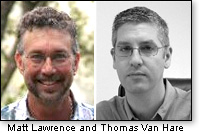 Lawrence and Van Hare's information is supplemented in this column by counterintelligence expert Chris Simmons, Executive Director of the Cuban Intelligence Research Center (CIRC), whose full-time mission includes tracking and uncovering Cuban agents at work in America.
Lawrence and Van Hare's information is supplemented in this column by counterintelligence expert Chris Simmons, Executive Director of the Cuban Intelligence Research Center (CIRC), whose full-time mission includes tracking and uncovering Cuban agents at work in America.
This half of the story highlights the role of our not-so-friendly neighborhood spies in the cold-blooded murder of American citizens.
As Betrayal details, the shootdown was actively facilitated by a Cuban spy ring operating on American soil, which had personnel deployed both within and outside of the U.S. Government. That spy ring, called La Red Avispa or the Wasp network, was a nest of agents originally set up to create tensions between the U.S. media and Cuban exile leaders in Miami — but as Lawrence and Van Hare point out, Cuban subversion reached far beyond that smaller goal. On Fidel Castro's personal order, the murder was carried out even at a time when then- President Bill Clinton was making positive and friendly overtures toward Cuba. It was those agents of La Red Avispa who went so far as to "break the rules" of espionage, which would stop short at even the thought of murdering innocent civilians. That such an order was actually issued by Cuba should raise a red flag forthose who wish to extend the hand of friendship toward Havana.
In an outline provided to this column, Van Hare and Simmons say the often underestimated Cuban intelligence service (the DGI) is in fact the 6th best in the world. It is highly proficient and has helped enable Cuba to compromise U.S. military operations in Latin American hotspots, as well as both wars in Iraq, having even gone so far as to forewarn Saddam of U.S. intentions to invade.
Cuba has also emerged as the world's premiere intelligence trafficker, and nations such as Russia and Communist China almost routinely (and covertly) procure intelligence from Castro's DGI. For Cuba, selling such intelligence not only is a way to attack our nation. It is also a leading source of cash in an economy that does justice to the very term "failed Soviet state."
Cuba's Queen of Spies
In key positions within the bowels of the U.S. Defense Intelligence Agency (DIA) for 17 years was one of the most dangerous spies ever to penetrate the workings of the U.S. government.
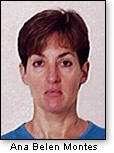 Ana Belen Montes was the senior briefer, literally in charge of coordinating the entire inter-agency intelligence gathering effort for the U.S.A. She was routinely called upon to provide classified briefings to top officials within the White House, Capitol Hill, the State Department, and the Defense Department. She was the key officer in charge of coordinating the U.S. intelligence estimate of Cuba, its leaders, and its intentions. But everything she wrote was co-written by Castro.
Ana Belen Montes was the senior briefer, literally in charge of coordinating the entire inter-agency intelligence gathering effort for the U.S.A. She was routinely called upon to provide classified briefings to top officials within the White House, Capitol Hill, the State Department, and the Defense Department. She was the key officer in charge of coordinating the U.S. intelligence estimate of Cuba, its leaders, and its intentions. But everything she wrote was co-written by Castro.
Thomas Van Hare noted to us that "Montes was the most damaging of the types of spies America faces, not so much charged with photographing and stealing documents as creating false secrets and 'truths' about our enemies that pollute our understanding of what is really happening in the world."
In the wake of the 1996 shootdown, Ana Montes was a key figure offering military options for retaliation to the President of the United States and the Pentagon. Her participation at the secret Pentagon meeting both skewed our own map of how to respond to the shootdown and also resulted in the entire plan being reported to Havana — before it was ever implemented. President Clinton, naturally, avoided any military response.
Therein, a lesson for the current president: Just the fear of retaliation can be a deterrent. It is hard to believe the Cubans would have been so bold had they targeted America during the tenure of Ronald Reagan or either of the two Bushes.
Simmons's CIRC makes note that Fidel Castro himself may have personally helped to manage Montes' spy operations, since Fidel has shown an interest in helping manage his dictatorship's highest-level assets.
But her very participation in the Pentagon meeting was to be her final undoing. It was there that one of her colleagues at DOD raised an eyebrow of suspicion when Montes took a cell phone call during that high-level hush-hush Pentagon meeting prompted by the MiG attacks. During those sessions, it was understood that no outside calls were to be taken. In fact, cell phones were left behind and switched off.
Castro's direct pipeline into the Pentagon
But Montes took her cell phone with her and left it switched on. Meanwhile, her Cuban handlers were worried. They knew she supposedly couldn't communicate with them while in the meeting. Thus, they feared that if a military response was authorized, she would not be able to tell them about it until the response was over. In a panic, they called her cell.
Reg Brown — a second DIA analyst at the gathering — became mildly suspicious when Montes answered her cell. When she returned and announced she would have to leave by 8 p.m., that's when Brown's suspicions were no longer mild. In his head, the metaphoric alarm bells went off big time. In the midst of a crisis, you don't take outside calls and above all, you don't leave early. You stay to the end.
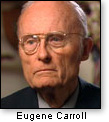 And there's more
And there's more
Subsequently, Brown learned that Ana Montes had scheduled Admiral Eugene Carroll's meetings, including the trip to Cuba (see last week's column) where Castro's henchmen plainly indicated Cuba was considering shooting down a Brothers to the Rescue (BTTR) plane if the group did not stop flying into Cuban airspace. Note that the Cuban premise that its airspace was routinely violated was a lie, a trumped up excuse to shoot down aircraft whose humanitarian mission was causing embarrassment to the Castro regime — and the lie was regularly endorsed by Montes herself, thus setting up a potential justification for what was in fact outright murder. Admiral Carroll's meeting to brief the White House and other senior officials about his visit to Cuba was scheduled by Montes herself, too conveniently delayed until just exactly one day before the shootdown.
Given the bureaucratic wheels of government, 24 hours forewarning was hardly enough time — as Lawrence and Van Hare put it — "to expect any real coordinated U.S. government response, yet it was still warning enough for the American public subsequently to believe that the U.S. had been reasonably forewarned about Havana's interest in stopping the Brothers to the Rescue.
It was a conveniently narrow time gap — convenient for Cuba. To Reg Brown, that timing was suspicious in the extreme, too much of a coincidence, with all the markings of an undercover "influence" espionage campaign aimed at public opinion — a little too clever by half.
However, Brown also knew that all he had was suspicion. Besides, Montes had a reputation as a take-no-prisoners type of manager — she could be vicious. Cross her in a meeting and you were toast. What if he reported her and the investigation proved a false lead, and she found out about it? For Brown, there would be hell to pay on both sides of the Potomac.
Tiny "coincidences" pile up
Nonetheless, after some hesitancy, Brown reported his suspicions to his friend and counter-intelligence officer Scott Carmichael. Carmichael called in Montes for a "routine" security briefing and confronted her with several other little glitches that didn't add up. He later turned up additional clues, but not enough to convict her. A few years later, he learned the FBI was searching for someone believed to be "a person of interest" at DIA.
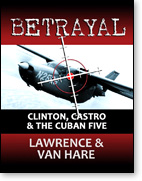 To make a long story short (you will have to read the Betrayal book to get the full fascinating investigatory trail), she was finally nailed, collared, and booted. Montes is now doing time (25 years) behind bars.
To make a long story short (you will have to read the Betrayal book to get the full fascinating investigatory trail), she was finally nailed, collared, and booted. Montes is now doing time (25 years) behind bars.
Treason is arguably a capital offense, but you and I — the taxpayers — are keeping this traitor housed, clothed, fed, and provided with healthcare. She'll be 69 by the time her sentence is up. The four murdered pilots — three of them American citizens — should be so lucky! The same applies to covertly deployed U.S. Army personnel in Central America whom Montes attempted to kill (and, through her passing of classified information, ultimately succeeded).
No fly-by-night subversive
There was nothing low-level about the position Montes occupied. And she was of immense help to Castro.
Montes even turned down a promotion, saying she preferred to remain in her position where her focus was exclusively on Cuba. You can just bet she wanted to stay put — probably at the insistence of the Castro's DGI. Like the early Soviet spies, Ana Montes was not doing it for money. She believed in Cuba's cause and was anti-U.S. As Thomas Van Hare noted in an exclusive interview with this writer, "Not only was she able to achieve the ends of Castro from deep within the U.S. Government, but she was able twist the truth around, thereby offering ready fodder to those who seem to believe that Cuba is just misunderstood."
She was in a position to know the identity of U.S. undercover agents in Cuba — and report them back to Castro. Small wonder that so many were caught. Some of those — under threat — were turned into double agents where they fed disinformation to the U.S. which Montes processed and legitimized within the intelligence community as "truth."
La Red Avispa
Authors Lawrence and Van Hare focus extensively on the nest of spies known as La Red Avispa that indiscriminately kept tabs on Cuban exiles in the Miami area. More maliciously, they breached U.S. military security.
Two agents of this insidious organization — Juan Pablo Roque and Rene Gonzalez — actually penetrated the Brothers to the Rescue (BTTR) organization itself. These two Castro agents fooled everyone, including the BTTR leader Jose Basulto.
Roque hid his undercover work so well that when he showed up on Cuban television following the shootdown with false accusations against the BTTR pilots, it was a surprise even to his family left behind. He had fled to Cuba the day before, leaving his wife and young son to their own devices. On his return to Cuba, he was promoted to the equivalent of a Lieutenant Colonel rank and given a medal.
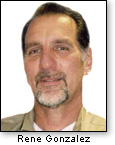 The spies of La Red Avispa were able to gain the most closely-guarded personal information about the other pilots, flight schedules, and radio encryption tables. Their information enabled Cuba to plan and execute the shootdown.
The spies of La Red Avispa were able to gain the most closely-guarded personal information about the other pilots, flight schedules, and radio encryption tables. Their information enabled Cuba to plan and execute the shootdown.
Gonzalez and Wasp undercover leader Gerardo Hernandez "devised and implemented a cover plan to enlist the assistance of unwitting Cuban-American [members of the U.S. Congress]...."
One such lawmaker, Rep. Ileana Ross-Lehtinen (R-Fla.), later recalled chillingly that the person the Pentagon sent personally to brief her on the BTTR shootdown was none other than the queen of spies herself — Ana Belen Montes.
Lesson learned?
It is too much to expect a Pelosi-Reid Congress to do its job and revive House and Senate committees whose sole responsibility was to investigate subversion and formulate legislation to deal with it. But — to borrow a phrase — Congress was never meant to be a potted plant. It has an oversight role, which it feely exercises in other areas. Why not spying and subversion? The intelligence committees serve a more limited purpose — mostly behind closed doors.
Congressional committees did a competent job years ago tackling Soviet spy cases and Soviet fronts on our soil — including — not incidentally — the Fair Play for Cuba Committee, whose membership rolls included Lee Harvey Oswald.
These investigating committees were finally abolished after sustained attack from expected quarters. Since then, subversion and spying — by Cuba, China, and others — have increased. You can kill the messenger, but you can't kill the message.
© Wes Vernon
April 6, 2009
For 32 years, the Soviet Union infused money and know-how into Cuba — its client-state just 90 miles from U.S. shores — until the flag went down on the Soviet empire. The history of failed states from the former Soviet "experiment" is paved in lives. Yet that final flag has yet to drop on Fidel Castro's Communist dictatorship, which was well schooled in the Soviet arts of spying and undermining the government of the United States. (Their job, after all,
 was half done early on, considering their many troops — witting and unwitting — right within the United States (i.e., don't worry about those naïve, trusting Americans, comrade; the ACLU will take care of them).
was half done early on, considering their many troops — witting and unwitting — right within the United States (i.e., don't worry about those naïve, trusting Americans, comrade; the ACLU will take care of them).A long history
At one time during the all-out Communist penetration of Washington — before, during and after World War II — there were as many as 349 Red agents throughout the government on the payroll of U.S. taxpayers working in key positions and reporting back to their spymasters in Moscow. They were stabbing America in the back with their deceit. The worst weren't even paid — they were motivated by ideological leanings.
Post World War II investigations — since verified by recent releases from the Soviet archives and the Venona transcripts of communications between Moscow and its subversive acolyte worms boring away within the U.S. bureaucracy — clearly showed every government agency had been penetrated — every single one except the FBI. (Post-J. Edgar Hoover, the FBI was also compromised.)
It is not farfetched to conceive that Russia — currently through Vladimir Putin's puppet president, Dmitry Medvedev — has been mentoring or otherwise assisting Cuba's spying in more recent times. Certainly, as the old saying goes, "Nations don't have friends, they have interests."
The student learns from the teacher
Last week, this column dealt with the Castro government's cold-blooded murder of Americans in February 1996. As our own government stood by and watched, Cuban MiG pilots shot down two unarmed American Cessnas whose mercy mission was to rescue Cubans risking their lives by fleeing Cuba's "workers' paradise" in rafts across the 90 miles of treacherous seas between Cuba and Florida. What follows is drawn from the second half of the detailed and well-documented new book Betrayal: Clinton, Castro & the Cuban Five by Matt Lawrence and Thomas Van Hare — an extraordinary piece of investigative writing that was based on 13 years of investigation (available at www.mattlawrencebooks.com).
 Lawrence and Van Hare's information is supplemented in this column by counterintelligence expert Chris Simmons, Executive Director of the Cuban Intelligence Research Center (CIRC), whose full-time mission includes tracking and uncovering Cuban agents at work in America.
Lawrence and Van Hare's information is supplemented in this column by counterintelligence expert Chris Simmons, Executive Director of the Cuban Intelligence Research Center (CIRC), whose full-time mission includes tracking and uncovering Cuban agents at work in America.This half of the story highlights the role of our not-so-friendly neighborhood spies in the cold-blooded murder of American citizens.
As Betrayal details, the shootdown was actively facilitated by a Cuban spy ring operating on American soil, which had personnel deployed both within and outside of the U.S. Government. That spy ring, called La Red Avispa or the Wasp network, was a nest of agents originally set up to create tensions between the U.S. media and Cuban exile leaders in Miami — but as Lawrence and Van Hare point out, Cuban subversion reached far beyond that smaller goal. On Fidel Castro's personal order, the murder was carried out even at a time when then- President Bill Clinton was making positive and friendly overtures toward Cuba. It was those agents of La Red Avispa who went so far as to "break the rules" of espionage, which would stop short at even the thought of murdering innocent civilians. That such an order was actually issued by Cuba should raise a red flag forthose who wish to extend the hand of friendship toward Havana.
In an outline provided to this column, Van Hare and Simmons say the often underestimated Cuban intelligence service (the DGI) is in fact the 6th best in the world. It is highly proficient and has helped enable Cuba to compromise U.S. military operations in Latin American hotspots, as well as both wars in Iraq, having even gone so far as to forewarn Saddam of U.S. intentions to invade.
Cuba has also emerged as the world's premiere intelligence trafficker, and nations such as Russia and Communist China almost routinely (and covertly) procure intelligence from Castro's DGI. For Cuba, selling such intelligence not only is a way to attack our nation. It is also a leading source of cash in an economy that does justice to the very term "failed Soviet state."
Cuba's Queen of Spies
In key positions within the bowels of the U.S. Defense Intelligence Agency (DIA) for 17 years was one of the most dangerous spies ever to penetrate the workings of the U.S. government.
 Ana Belen Montes was the senior briefer, literally in charge of coordinating the entire inter-agency intelligence gathering effort for the U.S.A. She was routinely called upon to provide classified briefings to top officials within the White House, Capitol Hill, the State Department, and the Defense Department. She was the key officer in charge of coordinating the U.S. intelligence estimate of Cuba, its leaders, and its intentions. But everything she wrote was co-written by Castro.
Ana Belen Montes was the senior briefer, literally in charge of coordinating the entire inter-agency intelligence gathering effort for the U.S.A. She was routinely called upon to provide classified briefings to top officials within the White House, Capitol Hill, the State Department, and the Defense Department. She was the key officer in charge of coordinating the U.S. intelligence estimate of Cuba, its leaders, and its intentions. But everything she wrote was co-written by Castro.Thomas Van Hare noted to us that "Montes was the most damaging of the types of spies America faces, not so much charged with photographing and stealing documents as creating false secrets and 'truths' about our enemies that pollute our understanding of what is really happening in the world."
In the wake of the 1996 shootdown, Ana Montes was a key figure offering military options for retaliation to the President of the United States and the Pentagon. Her participation at the secret Pentagon meeting both skewed our own map of how to respond to the shootdown and also resulted in the entire plan being reported to Havana — before it was ever implemented. President Clinton, naturally, avoided any military response.
Therein, a lesson for the current president: Just the fear of retaliation can be a deterrent. It is hard to believe the Cubans would have been so bold had they targeted America during the tenure of Ronald Reagan or either of the two Bushes.
Simmons's CIRC makes note that Fidel Castro himself may have personally helped to manage Montes' spy operations, since Fidel has shown an interest in helping manage his dictatorship's highest-level assets.
But her very participation in the Pentagon meeting was to be her final undoing. It was there that one of her colleagues at DOD raised an eyebrow of suspicion when Montes took a cell phone call during that high-level hush-hush Pentagon meeting prompted by the MiG attacks. During those sessions, it was understood that no outside calls were to be taken. In fact, cell phones were left behind and switched off.
Castro's direct pipeline into the Pentagon
But Montes took her cell phone with her and left it switched on. Meanwhile, her Cuban handlers were worried. They knew she supposedly couldn't communicate with them while in the meeting. Thus, they feared that if a military response was authorized, she would not be able to tell them about it until the response was over. In a panic, they called her cell.
Reg Brown — a second DIA analyst at the gathering — became mildly suspicious when Montes answered her cell. When she returned and announced she would have to leave by 8 p.m., that's when Brown's suspicions were no longer mild. In his head, the metaphoric alarm bells went off big time. In the midst of a crisis, you don't take outside calls and above all, you don't leave early. You stay to the end.
 And there's more
And there's moreSubsequently, Brown learned that Ana Montes had scheduled Admiral Eugene Carroll's meetings, including the trip to Cuba (see last week's column) where Castro's henchmen plainly indicated Cuba was considering shooting down a Brothers to the Rescue (BTTR) plane if the group did not stop flying into Cuban airspace. Note that the Cuban premise that its airspace was routinely violated was a lie, a trumped up excuse to shoot down aircraft whose humanitarian mission was causing embarrassment to the Castro regime — and the lie was regularly endorsed by Montes herself, thus setting up a potential justification for what was in fact outright murder. Admiral Carroll's meeting to brief the White House and other senior officials about his visit to Cuba was scheduled by Montes herself, too conveniently delayed until just exactly one day before the shootdown.
Given the bureaucratic wheels of government, 24 hours forewarning was hardly enough time — as Lawrence and Van Hare put it — "to expect any real coordinated U.S. government response, yet it was still warning enough for the American public subsequently to believe that the U.S. had been reasonably forewarned about Havana's interest in stopping the Brothers to the Rescue.
It was a conveniently narrow time gap — convenient for Cuba. To Reg Brown, that timing was suspicious in the extreme, too much of a coincidence, with all the markings of an undercover "influence" espionage campaign aimed at public opinion — a little too clever by half.
However, Brown also knew that all he had was suspicion. Besides, Montes had a reputation as a take-no-prisoners type of manager — she could be vicious. Cross her in a meeting and you were toast. What if he reported her and the investigation proved a false lead, and she found out about it? For Brown, there would be hell to pay on both sides of the Potomac.
Tiny "coincidences" pile up
Nonetheless, after some hesitancy, Brown reported his suspicions to his friend and counter-intelligence officer Scott Carmichael. Carmichael called in Montes for a "routine" security briefing and confronted her with several other little glitches that didn't add up. He later turned up additional clues, but not enough to convict her. A few years later, he learned the FBI was searching for someone believed to be "a person of interest" at DIA.
 To make a long story short (you will have to read the Betrayal book to get the full fascinating investigatory trail), she was finally nailed, collared, and booted. Montes is now doing time (25 years) behind bars.
To make a long story short (you will have to read the Betrayal book to get the full fascinating investigatory trail), she was finally nailed, collared, and booted. Montes is now doing time (25 years) behind bars.Treason is arguably a capital offense, but you and I — the taxpayers — are keeping this traitor housed, clothed, fed, and provided with healthcare. She'll be 69 by the time her sentence is up. The four murdered pilots — three of them American citizens — should be so lucky! The same applies to covertly deployed U.S. Army personnel in Central America whom Montes attempted to kill (and, through her passing of classified information, ultimately succeeded).
No fly-by-night subversive
There was nothing low-level about the position Montes occupied. And she was of immense help to Castro.
Montes even turned down a promotion, saying she preferred to remain in her position where her focus was exclusively on Cuba. You can just bet she wanted to stay put — probably at the insistence of the Castro's DGI. Like the early Soviet spies, Ana Montes was not doing it for money. She believed in Cuba's cause and was anti-U.S. As Thomas Van Hare noted in an exclusive interview with this writer, "Not only was she able to achieve the ends of Castro from deep within the U.S. Government, but she was able twist the truth around, thereby offering ready fodder to those who seem to believe that Cuba is just misunderstood."
She was in a position to know the identity of U.S. undercover agents in Cuba — and report them back to Castro. Small wonder that so many were caught. Some of those — under threat — were turned into double agents where they fed disinformation to the U.S. which Montes processed and legitimized within the intelligence community as "truth."
La Red Avispa
Authors Lawrence and Van Hare focus extensively on the nest of spies known as La Red Avispa that indiscriminately kept tabs on Cuban exiles in the Miami area. More maliciously, they breached U.S. military security.
Two agents of this insidious organization — Juan Pablo Roque and Rene Gonzalez — actually penetrated the Brothers to the Rescue (BTTR) organization itself. These two Castro agents fooled everyone, including the BTTR leader Jose Basulto.
Roque hid his undercover work so well that when he showed up on Cuban television following the shootdown with false accusations against the BTTR pilots, it was a surprise even to his family left behind. He had fled to Cuba the day before, leaving his wife and young son to their own devices. On his return to Cuba, he was promoted to the equivalent of a Lieutenant Colonel rank and given a medal.
 The spies of La Red Avispa were able to gain the most closely-guarded personal information about the other pilots, flight schedules, and radio encryption tables. Their information enabled Cuba to plan and execute the shootdown.
The spies of La Red Avispa were able to gain the most closely-guarded personal information about the other pilots, flight schedules, and radio encryption tables. Their information enabled Cuba to plan and execute the shootdown.Gonzalez and Wasp undercover leader Gerardo Hernandez "devised and implemented a cover plan to enlist the assistance of unwitting Cuban-American [members of the U.S. Congress]...."
One such lawmaker, Rep. Ileana Ross-Lehtinen (R-Fla.), later recalled chillingly that the person the Pentagon sent personally to brief her on the BTTR shootdown was none other than the queen of spies herself — Ana Belen Montes.
Lesson learned?
It is too much to expect a Pelosi-Reid Congress to do its job and revive House and Senate committees whose sole responsibility was to investigate subversion and formulate legislation to deal with it. But — to borrow a phrase — Congress was never meant to be a potted plant. It has an oversight role, which it feely exercises in other areas. Why not spying and subversion? The intelligence committees serve a more limited purpose — mostly behind closed doors.
Congressional committees did a competent job years ago tackling Soviet spy cases and Soviet fronts on our soil — including — not incidentally — the Fair Play for Cuba Committee, whose membership rolls included Lee Harvey Oswald.
These investigating committees were finally abolished after sustained attack from expected quarters. Since then, subversion and spying — by Cuba, China, and others — have increased. You can kill the messenger, but you can't kill the message.
© Wes Vernon
The views expressed by RenewAmerica columnists are their own and do not necessarily reflect the position of RenewAmerica or its affiliates.
(See RenewAmerica's publishing standards.)


















